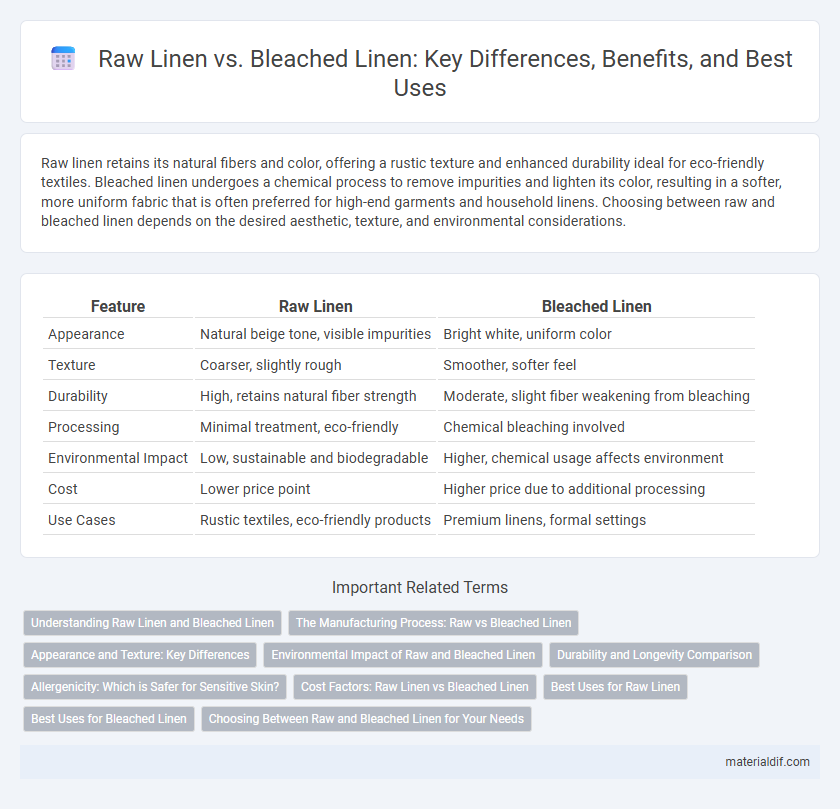Raw linen retains its natural fibers and color, offering a rustic texture and enhanced durability ideal for eco-friendly textiles. Bleached linen undergoes a chemical process to remove impurities and lighten its color, resulting in a softer, more uniform fabric that is often preferred for high-end garments and household linens. Choosing between raw and bleached linen depends on the desired aesthetic, texture, and environmental considerations.
Table of Comparison
| Feature | Raw Linen | Bleached Linen |
|---|---|---|
| Appearance | Natural beige tone, visible impurities | Bright white, uniform color |
| Texture | Coarser, slightly rough | Smoother, softer feel |
| Durability | High, retains natural fiber strength | Moderate, slight fiber weakening from bleaching |
| Processing | Minimal treatment, eco-friendly | Chemical bleaching involved |
| Environmental Impact | Low, sustainable and biodegradable | Higher, chemical usage affects environment |
| Cost | Lower price point | Higher price due to additional processing |
| Use Cases | Rustic textiles, eco-friendly products | Premium linens, formal settings |
Understanding Raw Linen and Bleached Linen
Raw linen retains its natural fibers and tan color, offering a coarser texture and greater durability due to minimal processing. Bleached linen undergoes chemical treatments to remove natural pigments, resulting in a softer, brighter white fabric ideal for delicate applications. The choice between raw and bleached linen impacts breathability, strength, and aesthetic versatility in textile use.
The Manufacturing Process: Raw vs Bleached Linen
Raw linen undergoes minimal processing, preserving its natural fibers and inherent strength through mechanical methods like retting and scutching without chemical treatments. In contrast, bleached linen is subjected to chemical bleaching agents such as hydrogen peroxide to remove natural pigments, resulting in a lighter, more uniform fabric appearance. The manufacturing process of bleached linen involves additional washing and drying cycles to ensure softness and enhanced whiteness, which can slightly weaken the fiber compared to raw linen.
Appearance and Texture: Key Differences
Raw linen exhibits a natural beige or light brown color with a coarse, slightly rough texture due to the presence of natural plant fibers and impurities. Bleached linen, by contrast, features a bright white or light cream hue and a smoother, softer feel achieved through chemical or natural bleaching processes that remove the fibers' natural oils and pigments. The bleaching process enhances linen's appearance for refined aesthetics while slightly altering its original texture and reducing its natural firmness.
Environmental Impact of Raw and Bleached Linen
Raw linen production involves minimal chemical processing, significantly reducing water pollution and chemical runoff compared to bleached linen, which requires intensive use of chlorine-based bleach and other toxic agents harmful to aquatic ecosystems. The energy consumption of bleaching processes also contributes to higher carbon emissions, while raw linen maintains a more sustainable carbon footprint by preserving natural fiber qualities without additional treatment. Choosing raw linen supports eco-friendly textile manufacturing practices by minimizing resource consumption and chemical waste discharge.
Durability and Longevity Comparison
Raw linen retains its natural fibers and is known for superior durability due to minimal chemical processing, preserving fiber strength for long-term use. Bleached linen undergoes chemical treatments that lighten color but can weaken fibers, potentially reducing longevity under frequent washing and wear. Choosing raw linen supports extended durability, especially in heavy-use applications like upholstery and workwear.
Allergenicity: Which is Safer for Sensitive Skin?
Raw linen retains natural fibers and minimal chemical processing, making it less likely to irritate sensitive skin due to the absence of bleaching agents. Bleached linen undergoes chemical treatments that can strip natural oils and introduce potential allergens, increasing the risk of skin reactions in sensitive individuals. For those with allergen concerns, raw linen offers a safer, more hypoallergenic option by preserving its organic properties.
Cost Factors: Raw Linen vs Bleached Linen
Raw linen typically costs less than bleached linen due to minimal processing and fewer chemical treatments, reducing production expenses. Bleached linen involves additional steps like chlorine or peroxide bleaching, increasing labor and material costs that translate to higher prices. The environmental impact of bleaching also factors into the cost, as sustainable practices can raise the price of bleached linen compared to raw linen.
Best Uses for Raw Linen
Raw linen is ideal for upholstery, drapery, and rustic home decor due to its natural texture and durability. Its unprocessed fibers retain strength and breathability, making it suitable for heavy-duty applications that require longevity. Raw linen's organic appearance enhances farmhouse-style interiors and eco-friendly designs, providing a natural, earthy aesthetic.
Best Uses for Bleached Linen
Bleached linen offers a crisp, bright appearance that enhances its suitability for formal table linens, delicate apparel, and elegant home decor, providing a refined finish that raw linen lacks. Its smooth texture and uniform whiteness make it ideal for embroidery, fine tailoring, and bridal wear, where purity and precision are essential. Bleached linen's enhanced aesthetic appeal and ability to hold dyes better also make it a popular choice for luxurious curtains and high-end bedding.
Choosing Between Raw and Bleached Linen for Your Needs
Raw linen retains its natural fibers and earthy texture, offering durability and a rustic aesthetic ideal for eco-conscious projects and artisan crafts. Bleached linen undergoes a chemical whitening process, resulting in a softer, more uniform fabric that enhances brightness and versatility for home decor and fashion applications. Selecting between raw and bleached linen depends on the desired texture, appearance, and environmental considerations tied to your specific use case.
Raw Linen vs Bleached Linen Infographic

 materialdif.com
materialdif.com